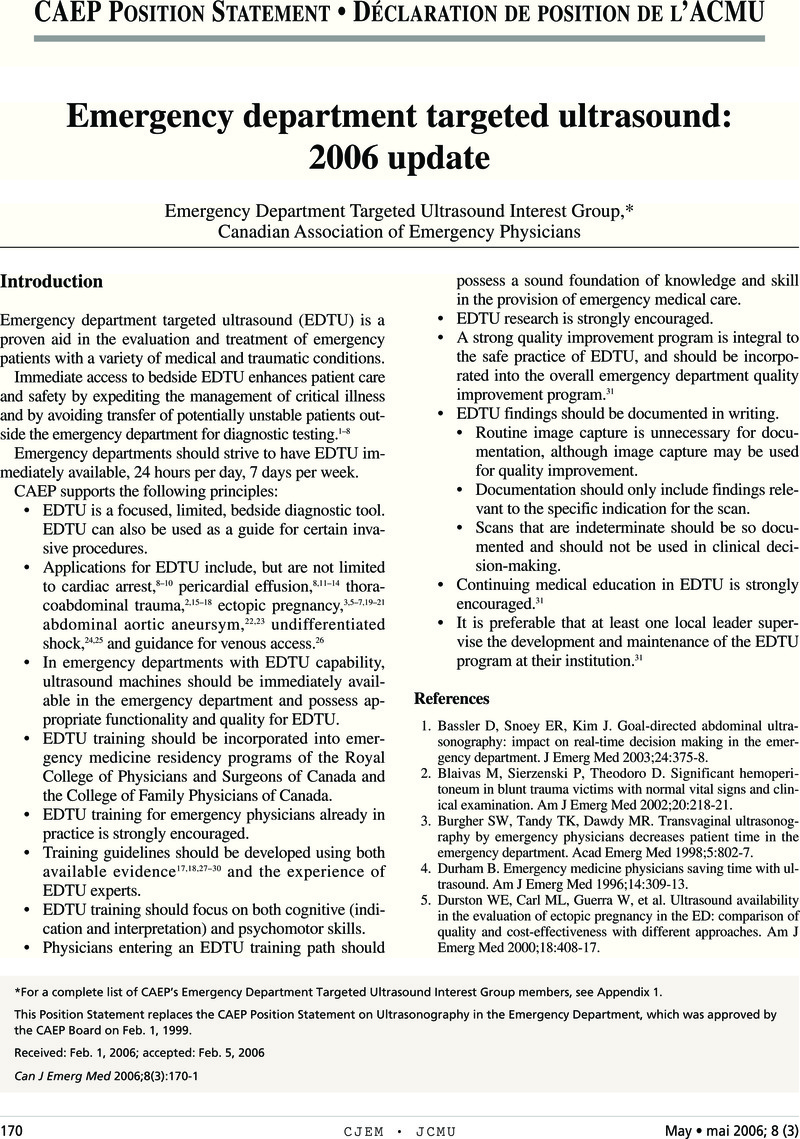Crossref Citations
This article has been cited by the following publications. This list is generated based on data provided by Crossref.
Henneberry, Ryan J.
Hanson, Amanda
Healey, Andrew
Hebert, Guy
Ip, Urbain
Mensour, Mark
Mikhail, Pierre
Miller, Steve
Socransky, Steve
and
Woo, Michael
2012.
Use of point of care sonography by emergency physicians.
CJEM,
Vol. 14,
Issue. 02,
p.
106.
Kim, Daniel J.
Theoret, Jonathan
Liao, Michael M.
Hopkins, Emily
Woolfrey, Karen
and
Kendall, John L.
2012.
The Current State of Ultrasound Training in Canadian Emergency Medicine Programs: Perspectives From Program Directors.
Academic Emergency Medicine,
Vol. 19,
Issue. 9,
Blyth, Lacey
Atkinson, Paul
Gadd, Kathleen
and
Lang, Eddy
2012.
Bedside Focused Echocardiography as Predictor of Survival in Cardiac Arrest Patients: A Systematic Review.
Academic Emergency Medicine,
Vol. 19,
Issue. 10,
p.
1119.
Piette, Eric
Daoust, Raoul
and
Denault, André
2013.
Basic concepts in the use of thoracic and lung ultrasound.
Current Opinion in Anaesthesiology,
Vol. 26,
Issue. 1,
p.
20.
Craig, Simon
Egerton‐Warburton, Diana
and
Mellett, Tanya
2014.
Ultrasound use in Australasian emergency departments: A survey of Australasian College for Emergency Medicine Fellows and Trainees.
Emergency Medicine Australasia,
Vol. 26,
Issue. 3,
p.
268.
Poley, Rachel A.
Newbigging, Joseph L.
Sivilotti, Marco L.A.
and
Moore, Chris
2014.
Estimated Effect of an Integrated Approach to Suspected Deep Venous Thrombosis Using Limited‐compression Ultrasound.
Academic Emergency Medicine,
Vol. 21,
Issue. 9,
p.
971.
Léger, Pierre
Fleet, Richard
Giguère, Julie Maltais-
Plant, Jeff
Piette, Éric
Légaré, France
and
Poitras, Julien
2015.
A majority of rural emergency departments in the province of Quebec use point-of-care ultrasound: a cross-sectional survey.
BMC Emergency Medicine,
Vol. 15,
Issue. 1,
Micks, Taft
Sue, Kyle
and
Rogers, Peter
2016.
Barriers to point-of-care ultrasound use in rural emergency departments.
CJEM,
Vol. 18,
Issue. 6,
p.
475.
Piette, Eric
Daoust, Raoul
Lambert, Jean
and
Denault, André
2017.
Lung Sliding Identification Is Less Accurate in the Left Hemithorax.
Journal of Ultrasound in Medicine,
Vol. 36,
Issue. 2,
p.
327.
Olszynski, Paul
Kim, Dan
Chenkin, Jordan
and
Rang, Louise
2018.
The core emergency ultrasound curriculum project: A report from the Curriculum Working Group of the CAEP Emergency Ultrasound Committee.
CJEM,
Vol. 20,
Issue. 2,
p.
176.
Olszynski, Paul
Kim, Daniel J.
Chenkin, Jordan
and
Rang, Louise
2018.
The CAEP Emergency Ultrasound Curriculum – Objectives and Recommendations for Implementation in Postgraduate Training: Executive Summary.
CJEM,
Vol. 20,
Issue. 5,
p.
736.
Chetioui, Adrien
Masia, Thibaud
Claret, Pierre-Géraud
Markarian, Thibaut
Muller, Laurent
Lefrant, Jean Yves
de La Coussaye, Jean Emmanuel
Roger, Claire
and
Bobbia, Xavier
2019.
Pocket-sized ultrasound device for internal jugular puncture: A randomized study of performance on a simulation model.
The Journal of Vascular Access,
Vol. 20,
Issue. 4,
p.
404.
Beckett, Nicole
Atkinson, Paul
Fraser, Jacqueline
Banerjee, Ankona
French, James
Talbot, Jo-Ann
Stoica, George
and
Lewis, David
2019.
Do combined ultrasound and electrocardiogram-rhythm findings predict survival in emergency department cardiac arrest patients? The Second Sonography in Hypotension and Cardiac Arrest in the Emergency Department (SHoC-ED2) study.
CJEM,
Vol. 21,
Issue. 6,
p.
739.
Chen, Robert
2019.
Synopsis of the point-of-care ultrasound assessment for perioperative emergencies.
Canadian Journal of Anesthesia/Journal canadien d'anesthésie,
Vol. 66,
Issue. 4,
p.
448.
Kim, Daniel J.
Olszynski, Paul
Smith, David J. W.
Lalande, Elizabeth
and
Woo, Michael Y.
2022.
Point of care ultrasound training in Canadian emergency medicine residency programs.
Canadian Journal of Emergency Medicine,
Vol. 24,
Issue. 3,
p.
329.



